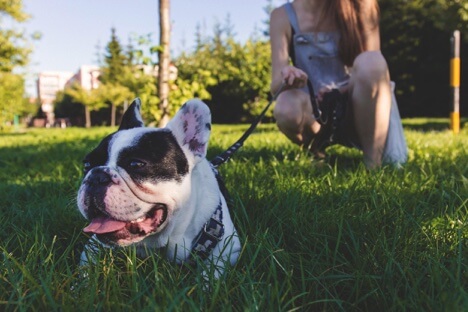
How to Be a Courteous Dog Owner
It’s no secret that dogs are man’s (and woman’s) best friend. In fact, dog ownership is up 29 percent in the past decade, which exceeds canine population growth. While it’s great that everyone from millennials to boomers wants to care for a furry friend, being a dog owner means you have to be conscientious of others around you — especially your neighbors since you’re in contact with them on a regular basis. Consider these tips on how to be a courteous dog owner.
Manage Their Behavior
At Home
Teaching your dog good manners starts at home. Jumping on family or visitors, barking incessantly, and failing to follow instructions can create problems for pets, their owners, and anyone else they encounter. To avoid these issues, your dog must be taught to control his or her impulsive behavior. There are five steps to mastering impulse control:
1. Teach your dog to look at you. Say your pet’s name, and drop a treat when they look your way.
2. Teach your dog to wait. Hold a treat or toy, and say your pet’s name. Wait for them to look at you calmly, without moving for the object, before you reward them with it.
3. Teach your dog to “leave it.” Hold some treats in your open hand, where your dog can see them. Close your hand when your dog tries to get the treats. Only give your dog the reward when he looks at you and waits patiently.
4. Teach your dog to settle down. When your dog gets overly excited about food or visitors, it helps to designate a spot where they can go to settle down. Direct your dog to the spot, and reward them when they go there on command.
5. Reward your dog for patient behavior. If your dog does the right thing, let him or her know. Praise for positive behavior begets more positive behavior.
At the Dog Park?
If you plan to take your pet out in public, you’ll also have to teach them to mind their manners around other people and pets. One tip is to practice impulse control in all types of environments and locations so the behavior starts to become second nature no matter where you are. A great place to start is the local dog park. The following safety tips can help ensure the health and happiness of everyone at the park:
? Vaccinate and use flea and tick prevention
? Use ID tags and microchips (the average cost to microchip your pet is $45)
? Research the best dog park for your pet
? Supervise your dog at all times
? Clean up after your pet
Finally, if your dog is aggressive, practice with a leash, head halter, or muzzle. Dog bites are no joke, and they can get you into trouble if your pooch is aggressive and nips at a neighbor or stranger. You may wind up in court, which means it’s likely that you’ll have medical expenses to deal with. In some cases, the owner is forced to euthanize their dog. Since this is such a serious matter, it’s best to consult a behavioral specialist to remedy any aggression problem.
Install a Fence
Installing a fence in your backyard is a great way to give your dog some breathing room to run around while having peace of mind that he won’t wind up in your neighbor’s yard. Just make sure it’s sturdy and high enough so that he can’t jump over it. In the Beaverton area, the average price to install a wood fence is $3,083, but it can be worth the cost to keep your pup safe and neighbors happy.
Clean Up Waste
Aside from being a smelly eyesore, dog feces is riddled with parasites that can affect you and your dog if you’re not careful. Since children play outdoors in dirt and mud, they’re more susceptible to infection. Regularly clean up after your dog in your own yard but definitely do so in public spaces. And never let your pooch relieve himself on your neighbor’s lawn.
Don’t Let Your Dog Be a Barker
You’re not going to make any friends in the neighborhood if your dog is perpetually barking and howling in the backyard. Work on the problem right away as it only gets worse with time. The first step is to determine the cause of the barking before you can work on “quiet” commands to control it. Here’s some additional advice:
? Make sure your dog gets plenty of regular exercise to release pent-up energy and tire him out
? Avoid leaving the dog alone for long periods of time
? Never comfort your dog when he’s barking; he’ll think you’re rewarding his behavior
? Don’t shout
? Avoid punishments like shock collars
? Get your dog’s attention by clapping or whistling. When the barking stops, present a reward in the form of a toy or treat
If you’re having problems controlling your pooch, consult a behavioral specialist. Getting help doesn’t mean you’re a failure as a dog owner. It’s the best decision for your safety and those who come in contact with your dog.
